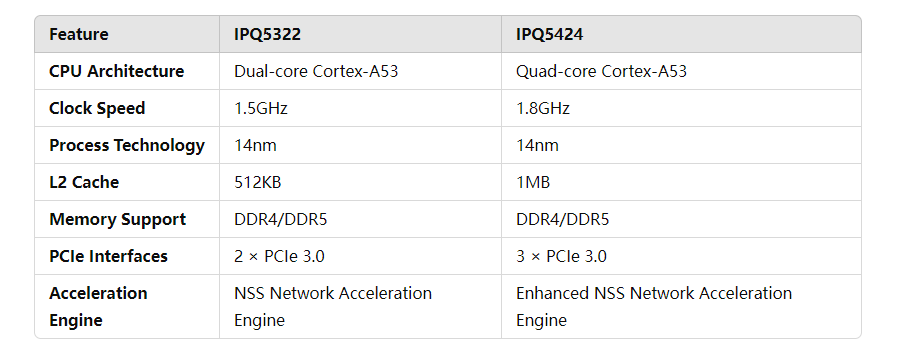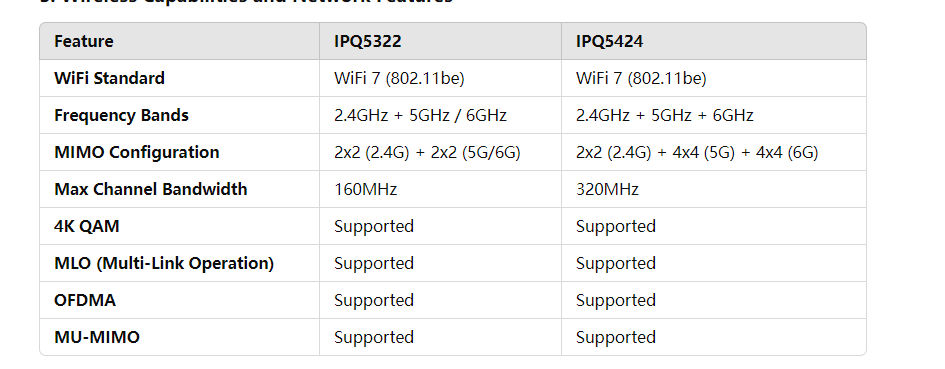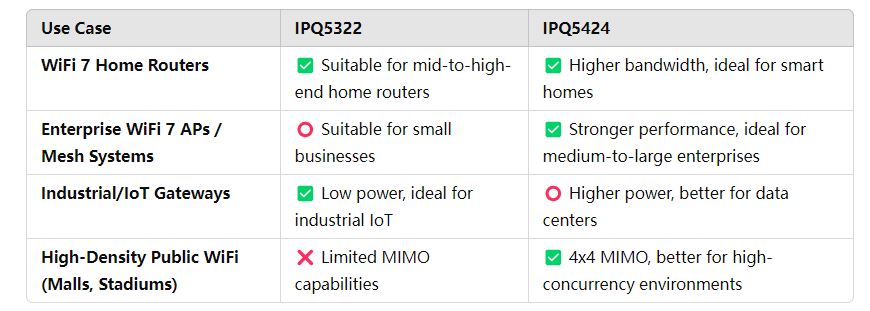IPQ5322 vs. IPQ5424: In-Depth Analysis and Comparison of WiFi 7 Network Processors
1. Overview
The IPQ5322 and IPQ5424 are Qualcomm's WiFi 7 network processors, designed for mid-to-high-end routers and enterprise networking equipment. Both utilize Qualcomm’s Networking Pro architecture, supporting advanced wireless features such as 4K QAM, 320MHz channel bandwidth, Multi-Link Operation (MLO), and MU-MIMO, significantly enhancing throughput and network stability.
However, despite being part of the WiFi 7 ecosystem, IPQ5322 and IPQ5424 exhibit notable differences in hardware configuration, performance, and application scenarios. This article provides a detailed comparison based on architecture, wireless capabilities, computing power, application scenarios, and cost-effectiveness.
2. Core Architecture and Processing Power

Analysis:
IPQ5424 features a quad-core architecture with a 1.8GHz clock speed, offering superior computing power over the dual-core 1.5GHz IPQ5322, making it more suitable for high-concurrency applications.
L2 cache is doubled (1MB vs. 512KB), improving data processing efficiency and reducing latency.
An additional PCIe 3.0 lane allows for more external device support, such as WiFi 7 network cards or storage devices.
Both feature Qualcomm's NSS network acceleration engine, but IPQ5424’s version is enhanced, offering better packet processing efficiency.
3. Wireless Capabilities and Network Features

Analysis:
IPQ5322 primarily supports a combination of 2.4GHz and either 5GHz or 6GHz, whereas IPQ5424 simultaneously covers all three bands (2.4GHz, 5GHz, and 6GHz), optimizing spectrum utilization.
IPQ5322’s lower MIMO configuration (2x2) is suitable for moderate throughput needs, while IPQ5424's 4x4 MIMO significantly enhances multi-user experiences.
IPQ5424 supports a 320MHz ultra-wide channel, doubling the data throughput compared to IPQ5322’s 160MHz, making it ideal for high-bandwidth applications such as 8K video streaming and VR/AR.
Both support WiFi 7 features like MLO, OFDMA, and MU-MIMO, but IPQ5424’s multi-band capability makes it superior in high-density environments.
4. Interfaces and Expandability

Analysis:
IPQ5424 offers higher-spec Ethernet ports (10G + 2.5G), making it more suitable for enterprise and high-performance home gateways than IPQ5322’s 2.5G + 1G configuration.
Both support USB 3.0 and similar storage interfaces, enabling external storage or NAS functionality.
5. Power Consumption and Cooling
Analysis:
IPQ5322’s low power consumption (~5W) makes it ideal for fanless designs, such as home routers and small business APs.
IPQ5424 consumes more power (~8W) and typically requires active cooling (heatsinks or fans), but its performance boost justifies the extra power usage.
6. Application Scenarios

Summary:
IPQ5322 is well-suited for mid-range markets, such as high-performance home WiFi 7 routers, small business gateways, and low-power IoT gateways.
IPQ5424 is better for high-end markets, such as enterprise-grade WiFi 7 APs, large-scale Mesh networks, and high-density environments like shopping malls and hotels.
7. Cost and Market Positioning
IPQ5322 has a lower cost, making it ideal for price-sensitive markets, such as consumer-grade WiFi 7 routers and cost-effective enterprise APs.
IPQ5424, on the other hand, is positioned for the high-performance segment, targeting enterprise-grade networking equipment and ISP-level CPE devices.
8. Conclusion
Both the IPQ5322 and IPQ5424 are Qualcomm WiFi 7 SoCs, but they differ in CPU performance, wireless capabilities, and expandability. The IPQ5322 is optimized for low power consumption and cost-effectiveness, making it suitable for consumer and small business applications. Meanwhile, the IPQ5424 delivers higher throughput and multi-band support, making it ideal for high-performance networking scenarios.
Recommendation:
For cost-effective, mid-tier applications such as home or small business use – choose IPQ5322.
For high-performance, high-density environments with heavy network loads – choose IPQ5424.

Comments
Post a Comment